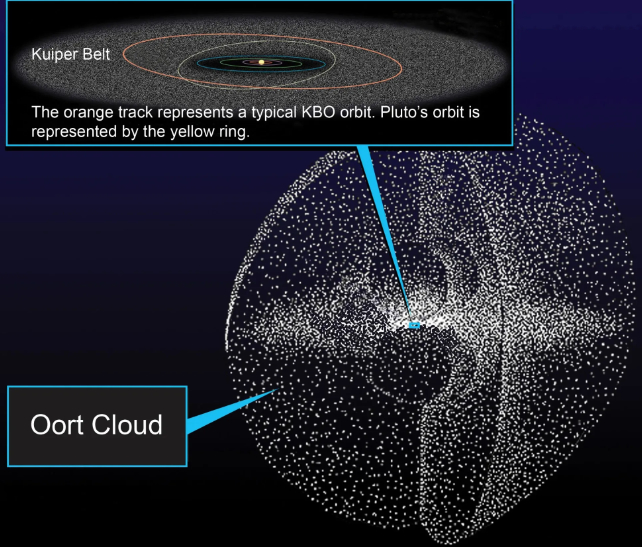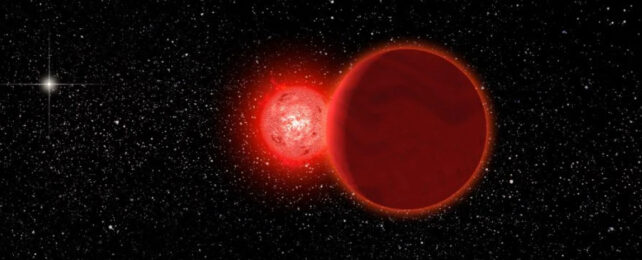If our Solar System seems stable, it's because our short lifespans make it seem that way. Earth revolves, night follows day, the Moon moves through light and shadow, and the Sun hangs in the sky.
But in reality, everything is moving and influencing everything else, and the fine balance we observe can easily be disrupted. Could passing stars have disrupted Earth's orbit and ushered in dramatic climatic changes in our planet's past?
A stellar flyby is when another star passes close enough to our Solar System to cause some disruption. Our neighbourhood in the Milky Way is relatively sparsely populated, so stellar flybys are rarer than in other parts of the galaxy. But they still occur.
The most well-known one was probably Scholz's star. About 70,000 years ago, it passed through the Oort Cloud, our Solar System's outlying repository of long-period comets and icy planetesimals.
It may have perturbed some comets from the Oort Cloud, but if it did, we won't know for a couple of million years. That's how long it would take for a comet to reach the inner Solar System.

Scholz's star illustrates the risk of stellar flybys. Scientists have wondered if these flybys have affected Earth's climate in the past by altering the planet's orbit.
New research that will appear in The Astrophysical Journal examines stellar flybys to see if this is true. It's titled "No influence of passing stars on paleoclimate reconstructions over the past 56 million years." The authors are Richard Zeebe and David Hernandez. Zeebe is from the School of Ocean & Earth Science & Technology at the University of Hawaii, and Hernandez is from the Department of Astronomy at Yale University.
"Passing stars (also called stellar flybys) have notable effects on the Solar System's long-term dynamical evolution, injection of Oort cloud comets into the solar system, properties of trans-Neptunian objects, and more," the authors write.
"Based on a simplified Solar System model, … it has recently been suggested that passing stars are also an important driver of paleoclimate before ∼50 Myr ago, including a climate event called the Paleocene-Eocene Thermal Maximum (PETM) (∼56 Myr ago)."
The PETM saw a 5–8 °C (9–14 °F) rise in global temperature and a massive influx of carbon into the atmosphere and oceans. It took 10,000 or 20,000 years for the temperature to rise and it lasted for about 100,000 or 200,000 years.
Its effect on the biosphere was massive. Many marine organisms went extinct, tropical and sub-tropical regions extended toward the poles, and primates and other mammals appeared.

The cause is still debated, and there are several hypotheses. They include volcanic eruptions, comet impact, the release of methane clathrates, and orbital forcing.
Researchers think that the giant planets play an important role during stellar flybys. When a roaming star passes by, the giant planets' gravitational fields can amplify the effect of the flyby and then alter the orbits of the smaller planets.
To find out if stellar flybys could be responsible for the PETM and other climatic changes, the researchers used a state of the art model of the Solar System and random stellar parameters in 400 simulations. The total number of stellar flybys was 1,800.
Other researchers who examined the same issue found that stellar flybys could've altered Earth's paleoclimate.
In a paper published last year, planetary scientists Nathan Kaib and Sean Raymond said, "Here we present simulations that include the Sun's nearby stellar population, and we find that close-passing field stars alter our entire planetary system's orbital evolution via their gravitational perturbations on the giant planets."
They also wrote, "Although it takes tens of [millions of years] for the effects of stellar passages to significantly manifest themselves, the long-term orbital evolution of the Earth and the rest of the planets is linked to these stars."
However, Zeebe, and Hernandez reached a different conclusion. "In contrast to Kaib and Raymond, we find no influence of passing stars on paleoclimate reconstructions over the past 56 Myr," they write.
One of the reasons for the different results is the completeness of the models used to understand the flybys. Some Solar System models, for example, excluded the Moon.
"Running accurate state-of-the-art Solar System models that include all known secondary effects is computationally expensive," the authors write. "As a result, long-term studies on, e.g., Gyr-timescale tend to be based on simplified Solar System models, or the outer planets alone."
By using a more complete Solar System model, Zeebe and Hernandez showed that stellar flybys are not likely behind Earth's dramatic paleoclimate shifts, like the PETM. They point out that the Moon has a stabilizing effect, and models that exclude it reach suspect conclusions.
"In contrast, using a state-of-the-art Solar System model, including a lunar contribution and J2 (the Moon and Sun's quadrupole moment), and random stellar parameters, we find no influence of passing stars on paleoclimate reconstructions over the past 56 Myr," the authors explain. Even extremely close flybys seem to have no effect.
There have been many stellar flybys in the past and there'll be many more in the future.
The orange dwarf Gliese 710 is expected to come within 0.1663 light-years or 10,520 astronomical units in about 1.29 million years. It has an 86 percent chance of passing through the Oort Cloud, and some researchers say it could trigger a swarm of comets into the inner Solar System. Could this flyby trigger a dramatic shift in Earth's climate?
There's a lot of uncertainty, and understanding the past and future of stellar flybys and how they might affect Earth's climate comes down to how detailed our scientific models are.
"Our results indicate that a complete physics model is essential to accurately study the effects of stellar flybys on Earth's orbital evolution," the authors conclude.
This article was originally published by Universe Today. Read the original article.
